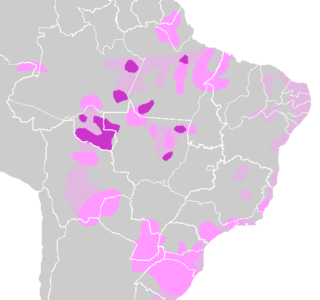
Tupi–Guarani is the most widely distributed subfamily of the Tupian languages of South America. It consists of about fifty languages, including Guarani and Old Tupi. The most widely spoken in modern times by far is Guarani, which is one of the two official languages of Paraguay.

The Zo'é people are a native tribe in the State of Pará, Municipality of Óbidos, on the Cuminapanema River, Brazil. They are a Tupi–Guarani people.

The Amanayé are a self-denomination Tupi-Guaranian people of Native South American nation of Brazil's Amazon basin. Residents of northeastern Brazil, they live between the cities of Belém and Brasília in the state of Pará, near the municipality of São Domingos do Capim. The name Amanayé supposedly means 'association of people', and appears in sources as Manajo and Amanajo as well. Part of the Amanayé may have taken the name of Ararandeuara, in reference to the igarapé near which they live. Sedentary farmers, hunters and gatherers, they speak Tupi and live on the Upper Capim River, in the State of Pará.
The Akuntsu are an indigenous people of Rondônia, Brazil. Their land is part of the Rio Omerê Indigenous Territory, a small indigenous territory which is also inhabited by a group of Kanoê. The Akuntsu were victims of a massacre perpetrated by Brazilian cattle ranchers in the 1980s and currently number just three individuals. It is unlikely that the Akuntsu language or culture will survive after their deaths, leading several observers to describe them as victims of genocide.
The Trumai are an indigenous people of Brazil. They currently reside within the Xingu Indigenous Park, in the state of Mato Grosso. They have a population of 258 in 2014. They were 97 in 2011 and 120 in 2006, up from a low of 26 in 1966.

The Xakriabá are an indigenous people of Brazil. One of the Gê peoples who spoke the Xakriabá dialect of the Akwe language, they used to live in the Tocantins River area. As of 2010, 9,196 Xakriabá people lived in the state of Minas Gerais.
The Kwazá are an indigenous people of Brazil. Most Kwazá live with the Aikanã and Latundê in the Tubarão-Latundê Indigenous Reserve in the province of Rondônia; however, some Kwazá live in the Terra Indígena Kwazá do Rio São Pedro. In 2008 their population was 40, up from 25 in 1998.

The Guajajara are an indigenous people in the Brazilian state of Maranhão. They are one of the most numerous indigenous groups in Brazil, with an estimated 13,100 individuals living on indigenous land.
The Anambé are an indigenous people of Brazil, living in the state of Pará, Brazil.
Tenetehára is a Tupi–Guarani language spoken in the state of Maranhão in Brazil. Sociolinguistically, it is two languages, each spoken by the Guajajara and the Tembé people, though these are mutually intelligible. Tembé was spoken by less than a quarter of its ethnic population of 820 in 2000; Guajajara, on the other hand, is more robust, being spoken by two-thirds of its 20,000 people.
Tapirapé is a Tupí-Guaraní language of Brazil spoken near the Araguaia River, in the border of the states of Mato Grosso and Tocantins. As of 2020, the language has around 917 speakers, who belong to the Tapirapé ethnic group.

The Huni Kuin are an indigenous people of Brazil and Peru. Their villages are located along the Purus and Curanja Rivers in Peru and the Tarauacá, Jordão, Breu, Muru, Envira, Humaitã, and Purus Rivers in Brazil.
The Zuruahã are an indigenous people of Brazil, living along the Purus River in the state of Amazonas.
The Kulina are an indigenous people of Brazil and Peru. 2,540 Kulina live in Amazonas and Acre in Brazil; while 400 live in southeastern Peru, along the Purus and Santa Rosa Rivers.
The Machinere are an indigenous people of Brazil, Bolivia, and Peru. They live along the Acre River in Bolivia. In Brazil they mostly live in the Mamoadate Indigenous Territory, although some live in the Chico Mendes Extractivist Reserve, both in Acre.
The Suruí are an indigenous people of Brazil who live in the state of Pará. They are a different people than the Suruí do Jiparaná.

Sônia Bone de Souza Silva Santos, usually known as Sônia Guajajara, is a Brazilian indigenous activist, environmentalist, and politician. A member of the Socialism and Liberty Party (PSOL), she was initially a candidate for President of Brazil in the 2018 Brazilian general election, before being chosen as the vice presidential running mate of nominee Guilherme Boulos. This made her the first indigenous person to run for a federal executive position in Brazil. In 2022, Guajajara was named one of the 100 most influential people in the world by Time.
The Tenetehára or Teneteharan languages are a subgroup of the Tupi–Guarani language family.

The Ministry of Indigenous Peoples is a cabinet-level federal ministry in Brazil. The ministry was established on 11 January 2023 under the government of Luiz Inácio Lula da Silva to advance and protect the interests of the Indigenous people of Brazil.







